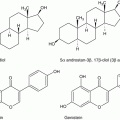Progestin
Half-life (hours)
Equivalent dose
Cyproterone acetate
48
1 mg
Nomegestrol acetate
30–50
(1.5) 2.5–5 mg
Chlormadinone acetate
34–39
3 mg
Drospirenone
30
3 mg
NETA
8–26
(1) 2.5–5 mg
MPA
14
10 mg
Dienogest
11
2–3 mg
Dihydrogesterone
2.5–6
10–20 mg
Micronized progesterone
2
200/300 mg
The use of the intrauterine device releasing Levonorgestrel (LNG-IUD) may be an alternative and effective approach, thus recent studies suggest higher rate of regression in the presence of complex endometrial hyperplasia (with or without atypias) and less hysterectomies compared to oral progestins.
Tranexamic acid, non-steroidal anti-inflammatory drugs (NSAIDs), Danazol, GnRH analogues, and selective progesterone receptor modulators (SPRMs) may be other pharmacological compounds in symptomatic patients presenting persistent dysfunctional bleeding. Surgical endometrial ablation may be effective in patients who are not responsive to pharmacological strategies [9–13].
Vasomotor symptoms (VMS) such as hot flushes and cold or night sweats are common transitional symptoms, which usually decline throughout the postmenopausal life; however, they are bothersome symptoms that affect nocturnal sleep and deteriorate quality of life.
Hot flushes are more frequent during the early phases of sleep and contribute to sleep disruption and long-term onset of anxiety, depressed mood, and sexual dysfunction. VMS and consequent sleep disturbance are bothersome symptoms and are often common reasons for midlife women to seek for the first time medical attention on menopausal transition problems.
Hypothalamic insensitivity to estrogens also explains why menopausal symptoms commonly appear during this transition, when women have rather high levels of estrogens, as well as why exogenous estrogens are effective in reducing the symptoms [12].
Estrogen withdrawal also results in higher frequency of osteopenia, osteoporosis, urogenital symptoms and, in the long term, in increased risk of cardiovascular diseases (CVD), metabolic syndrome, and cognitive decline [14].
Estrogen deficiency is the principal pathophysiologic mechanism that underlies the spectrum of these menopausal symptoms, and various estrogen formulations are prescribed as hormonal replacement therapy (HRT), which remains the most efficacious of available therapeutic options for alleviating the symptom burden of menopause. The addition of progesterone to estrogen in HRT aims to protect women with intact uteri against endometrial pathologies, including hyperplasia and cancer.
A potential for symptomatic benefit with any treatment option must take into consideration the nature and severity of a woman’s problems and be weighed against assessed treatment-related risks, individualized from the perspective of each patient’s exclusive health profile. Choice of therapy should additionally take into consideration an individual woman’s perspective and preferences (Tables 19.2 and 19.3).
Table 19.2
Treatment options and clinical indications
Treatment option | Benefits |
|---|---|
Systemic estrogen alone | Symptom relief Fracture risk reduction Osteoporosis prevention Improved QOL |
Systemic estrogen and progestogen | Symptom relief Fracture risk reduction Osteoporosis prevention Improved QOL Colon cancer risk reduction |
Low-dose vaginal estrogen | Relief from genitourinary syndrome of menopause |
Ospemifene (SERM) | Reduction of moderate to severe dyspareunia due to vulvo-vaginal atrophy |
TSEC combination of conjugated equine estrogen and BZA (SERM) | Symptom relief |
Tibolone (synthetic steroid with estrogenic, progestogenic and androgenic activity) | Symptom relief Fracture risk reduction Osteoporosis prevention Improved QOL Colon cancer risk reduction |
Selective serotonin reuptake inhibitors | Relief of vasomotor symptoms and anxiolytic |
Selective norepinephrine reuptake inhibitor | Relief of vasomotor symptoms |
Clonidine, an alpha adrenergic receptor agonist | Relief of vasomotor symptoms |
GABA-ergics | Relief of vasomotor symptoms |
Table 19.3
Pharmacological options for management of menopausal symptoms
Therapy | Formulations |
|---|---|
Systemic hormonal therapy | |
Estrogen | Oral, transdermal (patch, gel, spray), vaginal (ring), implant; as estradiol or synthetic estrogens |
Progestogen | Oral, vaginal, intrauterine; as progesterone or progestin (synthetic) |
Estrogen + progestogen | Combination (pill, patch) |
Tissue-selective estrogen receptor complex (TSEC) (conjugated equine estrogen + bazedoxifene [BZA], a selective estrogen receptor modulator [SERM] | Oral |
Ospemifene (SERM) | Oral |
Tibolone | Oral |
Androgen therapy Testosterone | Oral, vaginal Topical, oral, implant |
Nonhormonal therapies | |
Selective serotonin reuptake inhibitor class | Oral |
Selective norepinephrine reuptake inhibitor class | Oral |
Anti-seizure (Gaba-ergics) | Oral |
Alpha adrenergic receptor agonist class | Oral; transdermal |
Sedatives and hypnotics | Oral |
Complementary or alternative therapies (consistent benefit over placebo effects not demonstrated) | |
Soy/isoflavones | Oral |
Black Cohosh | Oral |
Vitamin E | Oral |
Acupuncture
Stay updated, free articles. Join our Telegram channel
Full access? Get Clinical Tree
 Get Clinical Tree app for offline access
Get Clinical Tree app for offline access

| |

